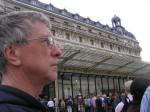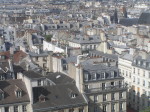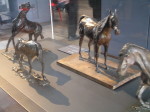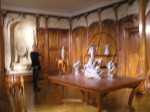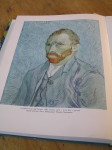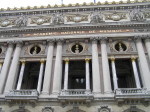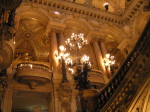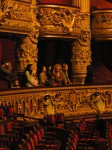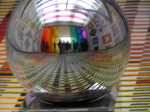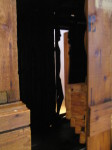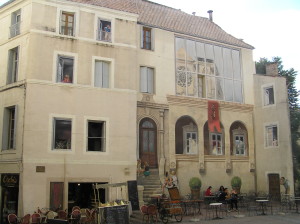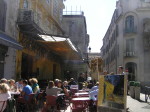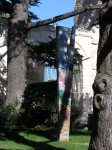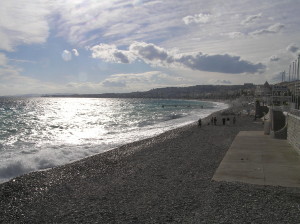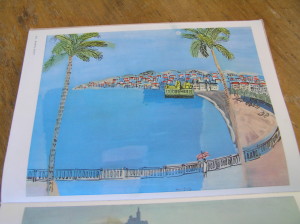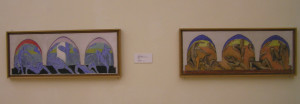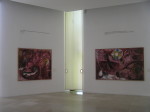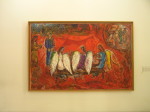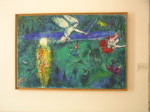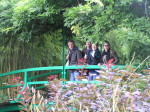DREAM COME TRUE ART TRIP AROUND FRANCE
Episode 1
In October 2013, I finally got to trip around France looking at great art. I’ve been dreaming of doing that for many, many years. I spent many hours in Paris art museums when I was young, particularly on an art study trip focussing on 1880 to 1940. But I haven’t been back to France since emigrating from England to New Zealand in the early 80s. I love NZ and I love lots of NZ art but the cradle of the European tradition of modern art is in Europe and Paris is something of a mecca. Both our daughters in France for a short time so what better excuse for Steve and me to go for it now? And, before meeting up with our girls that’s just what we did.
To start, Paris itself. First visit was the Musee d’Orsay which houses “fine art” and design in the Western tradition from 1848 to 1914. The museum has been converted, since I was last in Paris, from a railway station and the building itself inspired quite a few photos. I also photographed some sculpture and other art forms but not paintings.
There were notices saying no photos but lots of people doing it and little supervision. Naughty I know but I wasn’t as bad as the person I saw photographing a Vincent van Gogh with flash! That’s really bad news for the conservation of paintings. There was a room containing many van Gogh paintings from his period in Arles in the South of France. It’s hard to explain how exciting I find it to be in the company of the real paintings by my favourite artists – and van Gogh is certainly one of them. One of these paintings is a self-portrait I have used in reproduction to show my students the use of colour to express emotion rather than just represent what something, or someone, looks like physically. It seemed slightly weird, having looked at the picture in my big fat van Gogh book so many times, to be up close and personal with the real thing. I also enjoyed an Art Nouveau room (sorry photo blurry because light level so low) and some models of stage sets from the Opera Garnier.
As people who have seen my sculpture HEART IS WHERE THE HOME IS may realise, I’m very interested in creating environments – more about that later. The Musee d’Orsay took ages to get round everything and was exhausting for jetlagged people but it was a great start to the trip.
Next week: Art in Paris continued including more about the Opera Garnier and favourite artists.
Episode 2
The next day, we went to one of the 2 Parisian opera houses, the Opera Garnier. This is very ornate and photogenic but the main reason for going was that the ceiling of the auditorium was painted by Marc Chagall, another of my favourite artists. Of course it was beautiful (hard to imagine the unenviable task of being up there painting it) and, in Chagall fashion, contained all sorts of apparently disparate but bound to be connected images, for example, the Eiffel Tower, the opera house itself and..… a Jewish wedding.
Later that day we went to the Musee d’Art Moderne de la Ville de Paris, a museum I’d never heard of other than the fact it was featured on our tourist map so a nice surprise. Also a surprise that it had free entry, unusual in Paris. It houses modern historical and contemporary art. Of most interest to me were quite a few paintings by Pierre Bonnard and lots by Raoul Dufy. I love the way Bonnard flattens the perspective and fills the composition with perfect shapes, lovely colour harmonies and beautiful brushwork. Dufy isn’t one of my particular favourites but I was interested to see lots of his I’d never seen before either real or in reproduction. The main thing about him seems to be the way he floods the painting with one dominant colour and also adds sketchy drawing in paint that drifts in and out. I didn’t take any photos there as I had to check my bag in and didn’t have the cheek to get my camera out! Didn’t see anyone else taking any either.
Next week: More contemporary art and more photos ……. plus a disappointment.
Episode 3
On the 3rd day, Steve had had enough of art for the time being and he did a Sunday morning church crawl. Well, he went to Notre Dame and Sacre Coeur. At Notre Dame, just as he entered they started playing the organ and a choir sang and then what he described as an angel sang solo a capella. At Sacre Coeur he got no music but a good view of Paris and he also heard a Russian klezmer band at a station.
I went to the Pompidou Centre. The Pompidou is the Paris art museum I had previously spent the longest in and had happy memories of. Here, I met with a sad disappointment: The section that contains art covering the first half of the 20th century was closed for reorganisation. That means one of my very favourites, Wassily Kandinsky, and also art movements of great interest to me like the Fauves, the Expressionists and others I studied back at teachers college and on that Paris trip. However, I certainly enjoyed the contemporary section and photography was clearly completely allowed. It may be that because it’s so easy to take photos with phones now, they just don’t bother trying to stop people. I didn’t see anyone using flash this time and the light level was pretty bright anyway.
I photographed lots of works here for future reference. I’ve mentioned I’m very interested in created environments and there were many here. Some were large sculptures that you would be able to go inside – if you were allowed; others were whole rooms.
Next week: Down to the South of France and a Vincent van Gogh pilgrimage.
Episode 4
We left Paris for Montpellier in the south. This was mainly to visit friends and I didn’t visit any museums while there. But, in Montpellier, I did see a great example of trompe l’oeil. I took many photos I might use artwise in some way, in Montpellier and its surroundings.
And then to Arles. Now this was something of a pilgrimage because of van Gogh. Unfortunately there was a train strike that day and we had a delay of 2 hours which meant rather a rushed day. I had learnt that one could get a map to follow a trail around locations Vincent had painted when he lived and worked there. I did that and went around some of them in the limited time available. The best example was their number 1 but not the first I got to. This was “Le Café Le Soir” which I actually thought was called “Outdoor Café” and was painted in Place du Forum. Now previously, again back in the 1970s, I had been delighted to find that painting in the Kroller-Muller Museum in Holland. Now I was looking for the actual café, knowing it might not be there anymore. I was just about to ask someone when there it was right in front of me.
They’d kept it yellow of course and now called it Café Van Gogh. As well as the painting locations, I also photographed lots of other things in this Roman and medieval town – including a sculpture I think was probably referring to Vincent: a mosaic in the shape of a V that probably shows a detail of a painting.
Next week: Along the Mediterranean coast to Nice.
Episode 5
Last stop before going back to Paris (to meet one daughter and then go to the other in Caen) was Nice. One of the first things I looked at was the sweep of the bay painted by Raoul Dufy. We didn’t have time to go up the hills from which he must have looked at this view but I could see where that must be. I also know that there would be many days when the sky and sea are clearer and bluer than they were on this particular day. This isn’t a painting I saw in Paris, at least not this visit and I don’t remember whether I have seen it. This is a painting I have in a book and again, have often shown it to students. Adult students often want to paint a scene “as it is” with accurate perspective – even though that doesn’t always express what they themselves would like to “say” about the scene. Dufy’s painting says it’s blue, blue, blue – sea and sky – with a sensuous curve of the bay. He’s simplified the scene and lifted up the perspective to do that. And flooded that painting with blue.
Some artists, like van Gogh, went from northern Europe to the south of France and were stunned by the bright light and resulting intense colours around them. The effect of that on their painting has been a huge factor in the development of modern European art. And those of us who emigrated from northern Europe to New Zealand know that feeling! I haven’t been able to find out if Dufy ever lived in the South of France but I guess he must have visited as he’s buried in Nice!
In Nice, I visited the Matisse Museum. Henri Matisse was one of the leaders of the Fauve movement in the very early 20th century and Dufy was another member of that group. Matisse was also affected by the bright light of the Mediterranean region and painted in bright emotional colour. This museum was very interesting: It doesn’t have many works that I’ve ever seen either in the flesh or in books, which essentially means major works. It has a lot of things that have been donated by various members of Matisse’s family including quite a few paintings and sculptures; drawings and paint sketches for paintings; bits and pieces that look like trying out ideas for collage shapes; and actual objects that feature in Matisse’s painting or inspired him (camera card filled up so didn’t take as many photos as I’d have liked but this one is one of many studies for larger paintings).
Next week: A very favourite artist in Nice.
Episode 6
In Nice, we also went to one of the places I was most excited about and I wasn’t disappointed: The Chagall Museum, which Marc Chagall himself was involved with the establishment of. Oh, the paintings in there are wonderful. I think I would love Chagall’s paintings anyway for their complexity, their colour and brushwork, their floatiness but intensity. But I also feel something of a connection because my great grandparents probably came from similar Eastern European Jewish ghetto-like backgrounds to Chagall’s Russian village Vitebsk. Maybe think Fiddler on the Roof. My ancestors went to London as refugees in the late 19th century.
In the museum, I went around with a commentary which I don’t usually use. This added a lot to my knowledge, understanding and simply the things I noticed. The larger display area had large paintings illustrating Old Testament scenes/stories some of which Chagall had related to his own Jewish background and the modern Jewish experience. (He had got out of Europe and spent the years of World War 2 in the USA.)
The smaller area showed medium sized paintings responding to the poetic Song of Songs associated with King David and Bathsheba. Here, the commentary ended by encouraging the viewer to bask in the sensuality of the paintings and listen to some Bach! And it was clearly totally acceptable to photograph everything so, after I’d gone round looking and listening to the commentary, I went back round snapping away. I photographed almost all the work in there. And I also photographed quite a few bits in close-up. Well I couldn’t take the actual paintings home with me, could I? That probably wouldn’t have been acceptable.
Next week: Last stop on Dream Come True Art Trip Around France.
Episode 7
From Nice, we went back to Paris and met up with younger daughter who had been travelling with her school French class. Then the 3 of us went to Caen in Normandy where older daughter is living for a few months.
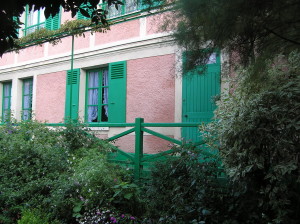
The last stop in the French art trip was to visit Claude Monet’s garden and house at Giverny, Normandy. If any of you are planning to do that, it would be quicker to visit from Paris. Also simpler as you can do it by public transport. But we wanted to do it all together and that meant hiring a car and Steve ticking the experience box of driving on the right! So quite an adventure but worth it. The garden is beautiful, even at its less than optimum time in autumn. I guess spring and summer would be even better – if you could see it for the tourists. Of course we walked around the famous water lily pond and argued about which bridge Monet painted (Steve was wrong). It was also interesting to look round the house and see the living and work space of the artist. Lots of photos in the garden but not allowed in the house.
That’s the end of my story about Dream Come True Art Trip Around France. Hope you enjoyed it!

